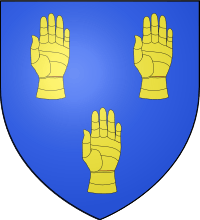Duke of Cleveland
Duke of Cleveland is a title that has been created twice, once in the Peerage of England and once in the Peerage of the United Kingdom. The dukedoms were named after Cleveland in northern England.
The first creation in 1670 (along with the barony of Nonsuch and the earldom of Southampton) was for Barbara Palmer, a mistress of King Charles II. The dukedom was created with a special remainder allowing it to be inherited by her first son, Charles FitzRoy, and his heirs male, then by her third son, George FitzRoy, 1st Duke of Northumberland, both being her illegitimate sons by Charles II. Charles FitzRoy was created Duke of Southampton, Earl of Chichester and Baron Newbury in 1675 and inherited the dukedom of Cleveland in 1709.
His son William inherited both dukedoms, but he had no issue, and since his uncle (Henry Fitzroy, 1st Duke of Grafton (died 1690), Barbara's 2nd son and his heirs male, had not been made eligible to inherit the peerage, the title became extinct upon his death.
The dukedom of Cleveland was created again in 1833 for William Vane, 3rd Earl of Darlington, along with the title Baron Raby. He was a great-grandson of Charles FitzRoy, the second Duke of the first creation, and had already been created Marquess of Cleveland in 1827. For more information on this creation, which became extinct in 1891, and the Vane family, see the Baron Barnard.
Dukes of Cleveland, first Creation (1670)
- Other titles (all): Countess of Southampton and Baroness Nonsuch, in the County of Surrey (1670)
- Barbara Palmer, 1st Duchess of Cleveland (1641–1709), a mistress of Charles II
- Other titles (2nd onwards): Duke of Southampton, Earl of Chichester and Baron of Newbury, in the County of Berkshire (1675)
- Charles FitzRoy, 2nd Duke of Cleveland, 1st Duke of Southampton (1662–1730), eldest (illegitimate) son of the 1st Duchess of Cleveland and Charles II
- William FitzRoy, 3rd Duke of Cleveland, 2nd Duke of Southampton (1698–1774), eldest son of the 2nd Duke of Cleveland. He died without issue, and his titles were extinct.
Dukes of Cleveland, second Creation (1833)

- Other titles: Marquess of Cleveland (1827), Earl of Darlington, in the County of Durham and Viscount Barnard, of Barnard's Castle in the county of Durham (1754), Baron Barnard, of Barnard's Castle in the Bishopric of Durham (1698), Baron Raby, of Raby Castle in the County Durham (1833)
- William Harry Vane, 1st Duke of Cleveland (1766–1842), great-grandson of the above 2nd Duke
- Henry Vane, 2nd Duke of Cleveland (1788–1864), eldest son of the 1st Duke
- William John Frederick Vane, 3rd Duke of Cleveland (1792–1864), second son of the 1st Duke
- Harry George Powlett, 4th Duke of Cleveland (1803–1891), youngest son of the 1st Duke. All of his titles except for Baron Barnard became extinct upon his death without issue.
Family Tree
| DUCHESS OF CLEVELAND, 1670 | |||||||||||||||||||||||||||||
| King Charles II (1630–r.1660–1685) | Barbara Palmer, 1st Duchess of Cleveland (1640–1709) | ||||||||||||||||||||||||||||
| Duke of Monmouth Dukes of Buccleuch | Duke of Northumberland | Dukes of Richmond & Lennox | |||||||||||||||||||||||||||
| Earl of Plymouth | Dukes of Grafton | Dukes of St Albans | |||||||||||||||||||||||||||
| DUKE OF SOUTHAMPTON, 1675 | |||||||||||||||||||||||||||||
| Charles FitzRoy, 1st Duke of Southampton, 2nd Duke of Cleveland illegitimate (1662–1730) | |||||||||||||||||||||||||||||
| Earl of Darlington | |||||||||||||||||||||||||||||
| William FitzRoy, 2nd Duke of Southampton, 3rd Duke of Cleveland (1698–1774) | Lady Grace Fitzroy (1697–1763) | Henry Vane, 1st Earl of Darlington (c.1705–1758) | |||||||||||||||||||||||||||
| Henry Vane, 2nd Earl of Darlington (1726–1792) | |||||||||||||||||||||||||||||
| DUKE OF CLEVELAND, 1833 | |||||||||||||||||||||||||||||
| William Harry Vane, 3rd Earl of Darlington, 1st Duke of Cleveland (1766–1842) | |||||||||||||||||||||||||||||
| Henry Vane, 4th Earl of Darlington, 2nd Duke of Cleveland (1788–1864) | William John Frederick Vane, 5th Earl of Darlington, 3rd Duke of Cleveland (1792–1864) | Harry George Vane (Powlett), 6th Earl of Darlington, 4th Duke of Cleveland (1803–1891) | |||||||||||||||||||||||||||
References
- ↑ Debrett's Peerage, 1968, p.115, which omits appaumée, useful in differentiating from Fane arms; concerning appaumée Cussans (1898) states: "In blazoning a Hand, besides stating what position it occupies, and whether it be the dexter or sinister, and erased or couped, it must be mentioned whether it be clenched or appaumé". (Cussans, John, Handbook of Heraldry, 2nd Edition, London, 1868, p.47, p.92)
%2C_Duchess_of_Cleveland_with_her_son%2C_Charles_Fitzroy%2C_as_Madonna_and_Child_by_Sir_Peter_Lely_(2).jpg)